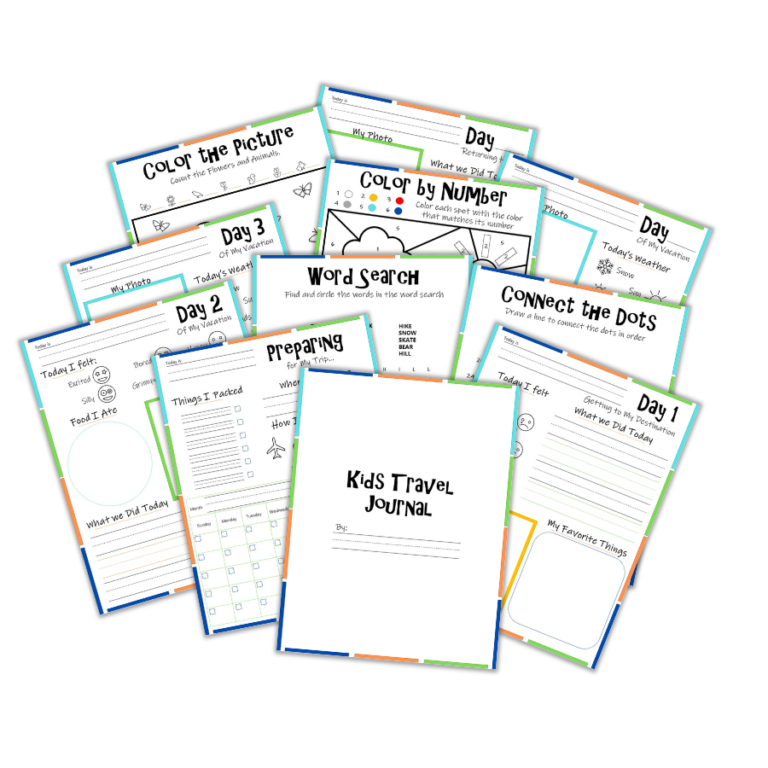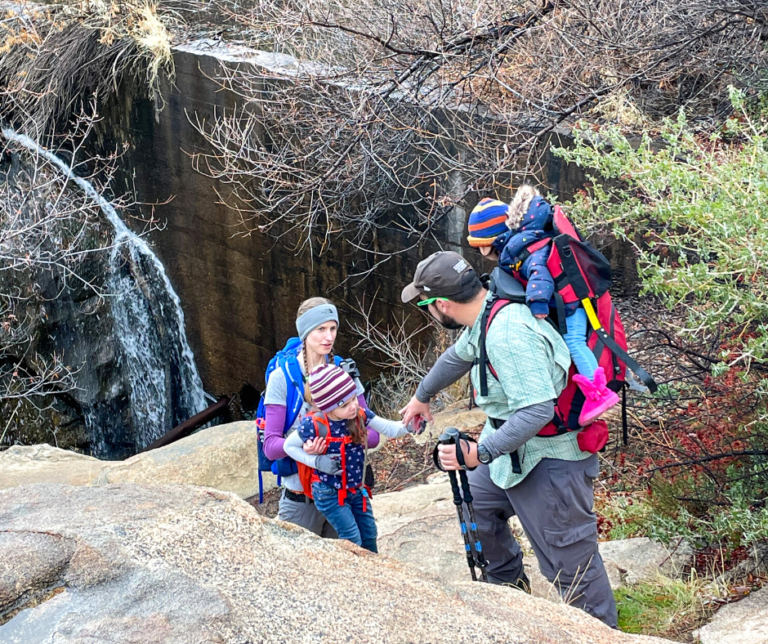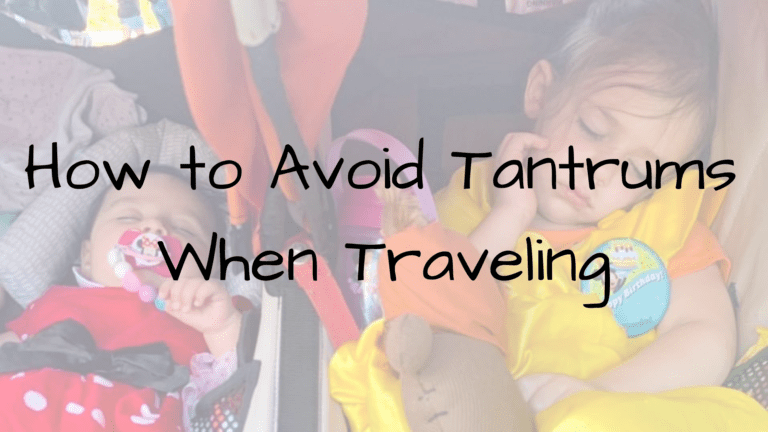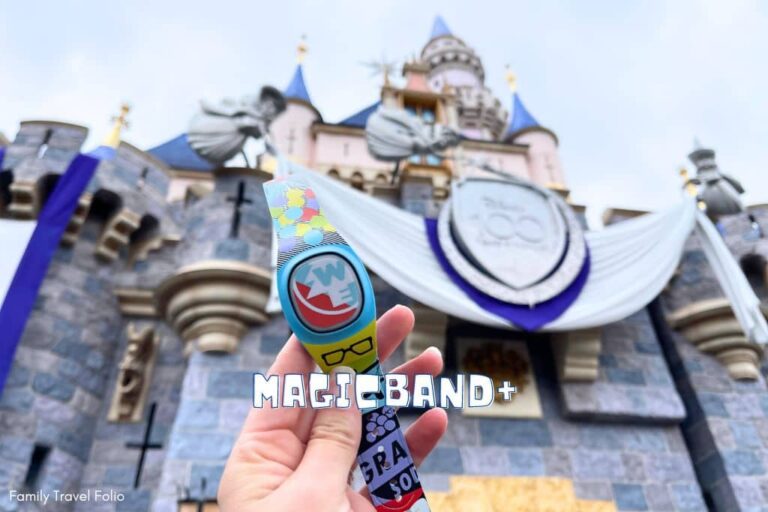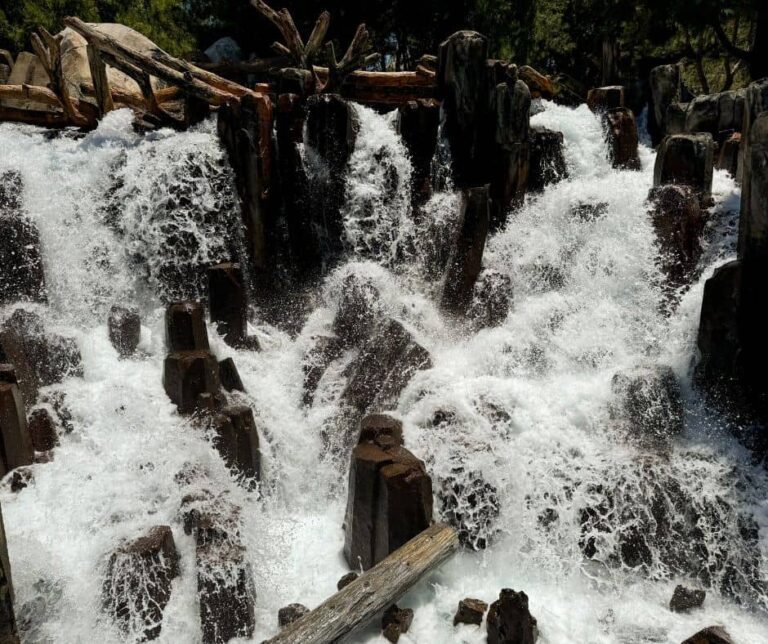How to Start Hiking with Kids: A Complete Guide for Families
There are Affiliate Links on this Page which may result in compensation for Family Travel Folio at no additional cost to you. Please read our Disclosure Policy for more information.
Looking to hike with your kids? Whether you’re new to hiking with children or want to make the experience more enjoyable, you’re in the right place!
My husband and I decided to spend less time in front of the TV and more time outdoors, so we took on the 52 Hike Challenge with our 5-year-old and 2-year-old. While we had hiked before, it was this challenge that truly turned us into regular hikers.
You don’t need to commit to 52 hikes in a year to make hiking with your family a regular thing.
This guide will give you everything you need to start your own family hiking adventures, from gear and snacks to choosing the best trail. All from a mom who’s hiked over 150 times with little ones!
Hiking with Kids Quick Start Guide
Already know you want to hike with your kids as a family? Here’s my boiled-down quick start guide. If you have more questions on the type of gear you may need, how to find a trail, or how to keep kids engaged while hiking, then read on!
You’ll find all of that info in this post, based on our experience hiking with our kids as babies, toddlers, and now elementary school-age kids. We’ve been on over 150 hikes as a family.
- Pick a family-friendly trail that matches your family experience level
- Schedule your hike on the calendar- this month!!!
- Go enjoy the hike!
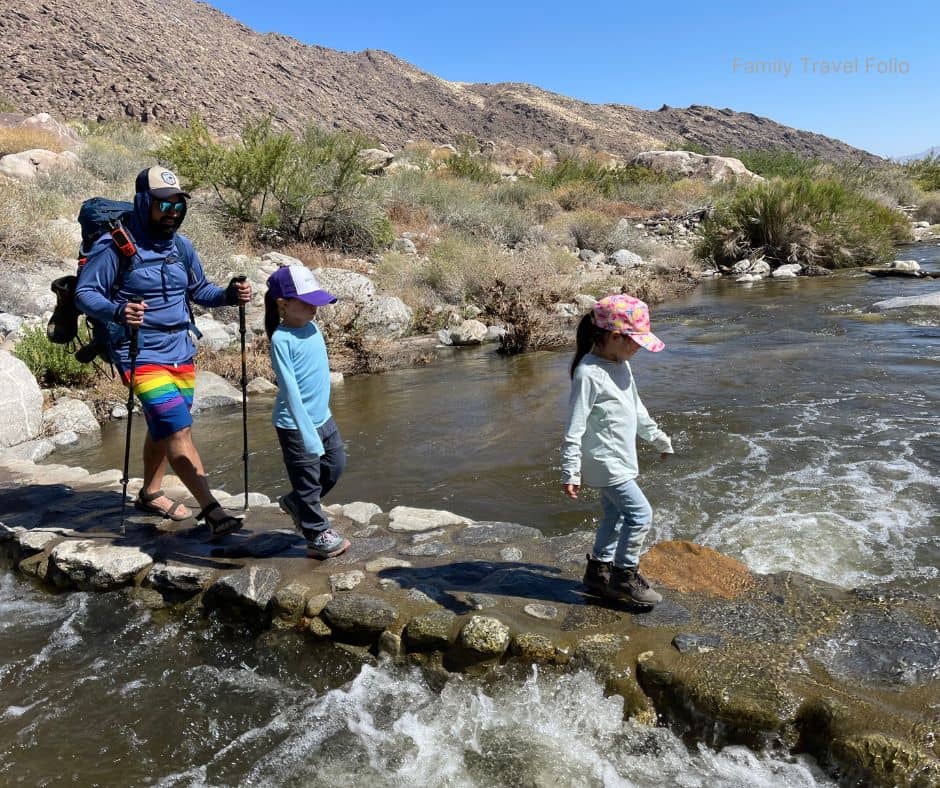
That’s it! It’s that simple. I think many people get hung up over the following:
- You’re worried your kids won’t cooperate on a hike
- You are apprehensive about how long a hiking trail you can manage
- You think you need to invest in expensive hiking gear and clothes that they’ll outgrow
- You don’t think of yourself as a “hiker,” so how can you get your family to hike
- You think all trails worth hiking need to be up a mountain, and you don’t really want to hike with kids up a mountain
If any of those worries resonate with you, then you’re in the right place! Don’t worry, all the starter info you need is in this guide. Be sure to save this post, and you can always reach out to me with any questions, just send me a DM on Instagram.
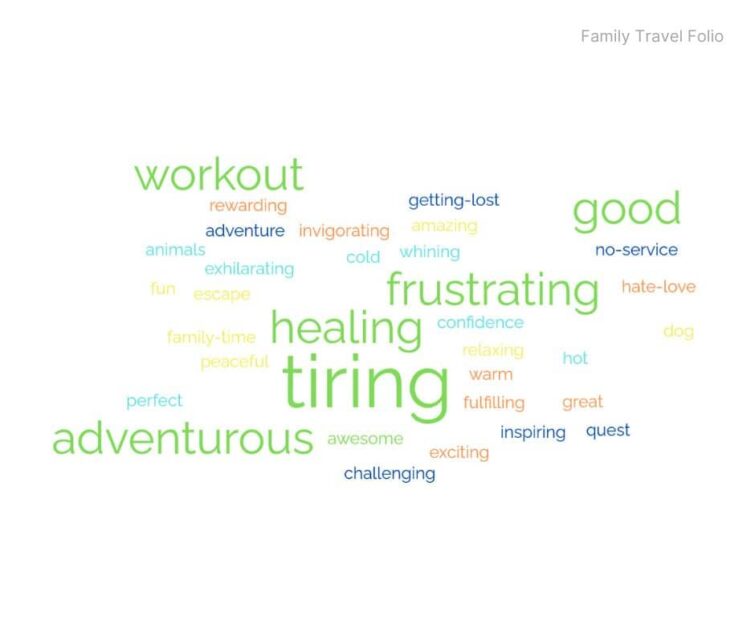
Essential Gear for Family Hiking Adventures
Sure, you may want to invest in fancy hiking boots or a top-of-the-line hiking carrier, but just start simple.
Gear you need to start hiking:
- Regular clothes that match the weather
- Sun protection
- Water & snacks
- First Aid Kit
- (+/- Bottles + Diapers)
Optional gear to make hiking easier:
- Hiking carrier for baby or toddler
- Hiking boots (helps with grip!)
- Lightweight, quick-dry hiking pants + shirt
- Basic GPS (if you’ll be hiking where there’s no signal)
Advanced gear you can opt to get later:
- Hiking poles
- Crampons and/or snowshoes (for winter adventures)
- Hiking backpacks
- Hiking water systems (water bladder, water filter, etc)
- Fancy GPS (no signal? map the trail ahead of time + use to contact for emergencies)
I know I put a hiking carrier as optional- and that’s because you can pick your trail! Choose one with a sidewalk or a flat path. Take the stroller or carry your baby in whatever carrier you already have. It doesn’t have to be a fancy “hiking” carrier for you to go for a walk. Don’t let that slow you down!
Our first kids’ hiking carrier was from a resale site. We met the owner in a school parking lot to buy one that they weren’t using anymore, and it worked great for a couple of years!
Only when we realized we weren’t going to stop hiking did we invest in better shoes, a better hiking carrier, and lightweight, quick-dry hiking pants.
We bought crampons for hiking on icy snow because we wanted to go on icy trails in winter– you don’t have to, especially when you’re getting started. Lots of room to learn and grow, just start simple.
Growing up, I always only wore jeans, a t-shirt, and tennis shoes until I was an adult and bought my first pair of hiking boots.

Kids Hiking Clothing
The right gear makes all the difference. I grew up hiking in tennis shoes, but when I invested in my first pair of hiking boots as a mom, I was sold!
Trying out hiking boots on our toddler was- dare I say- a game changer. I felt so much more confident in her toddling steps over rocks on the trail when she had a better grip.
If you want to go hiking on more challenging trails, invest in kids’ hiking shoes that fit well and are suitable for the trail difficulty. My reasoning for spending money on age-appropriate hiking shoes is that her little sister would use them too, and we could pass them off to friends and family.
Clothing for hiking and camping with kids is all about the layering system. Start with moisture-wicking base layers, add an insulating layer for warmth, and finish with a waterproof jacket for unpredictable weather.
Layers allow you to adjust based on the temperature and trail conditions. Of course, if it’s a hot day, a t-shirt and hiking shorts are perfect. If you’ll be hiking through scrub or there’s poison oak or poison ivy in the area, stick with lightweight hiking pants to protect your skin.
We were camping in Big Sur and hiked down to the beach- the first part of the trail was a narrow path with poison oak on each side. My husband ended up carrying each kid over the shrubs!
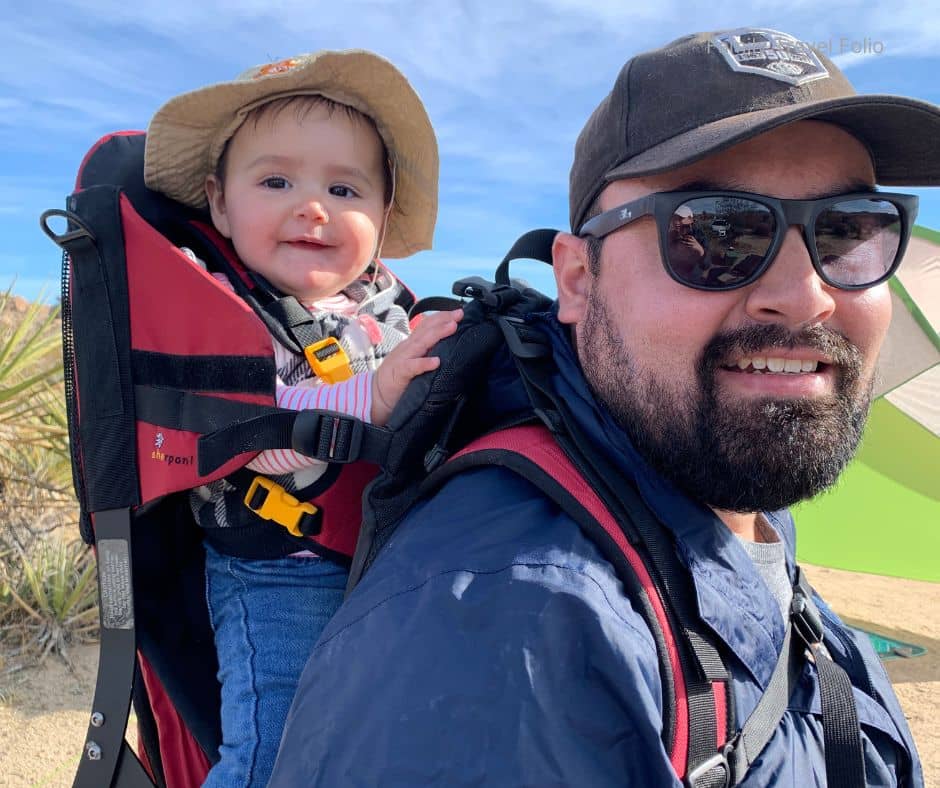
Kids’ Hiking Carriers and Backpacks
For babies and toddlers, child carriers are essential! We bought a lightly used hiking carrier which lasted through many of our adventures!
Our favorite hiking carrier has been from Kelty, and our friends used an Osprey hiking carrier. The biggest things to check for a kids’ hiking carrier are the following features.
The best kids hiking carrier should have:
- Adjustable straps to fit your body type
- Comfortable hiking carrier straps- you want some cushion
- Sun shade
- Pockets (for wipes, snacks, sunscreen, & diaper bag items)
Our girls love hiking so much, their birthday presents one year were hiking backpacks for kids. They could carry their snack and felt very important having a hiking backpack like mom and dad.
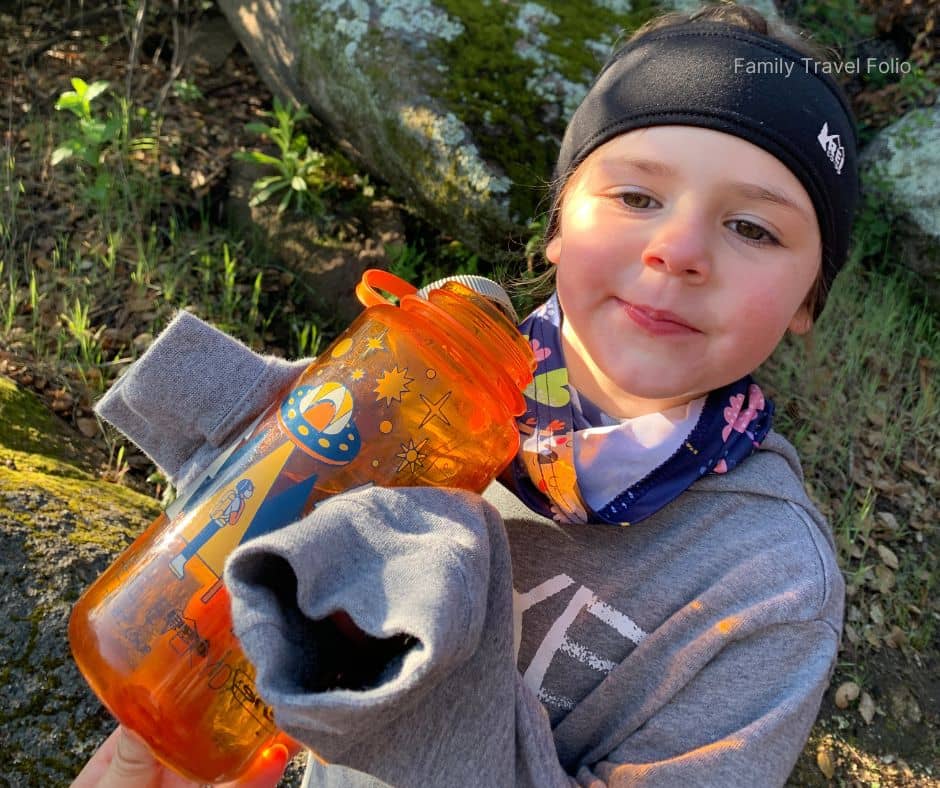
Stay Hydrated
Don’t forget family-sized hydration solutions! A large water bottle or a water bladder are good options. Just make sure to pack extra water in your hiking backpack and the car.
We like to use Ultima electrolytes to help stay extra hydrated. It comes in a variety of flavors, has zero sugar, and our girls absolutely love it!
If you’re hiking in remote areas, you should have a water filtration option to make sure you’ve got clean water throughout the day.
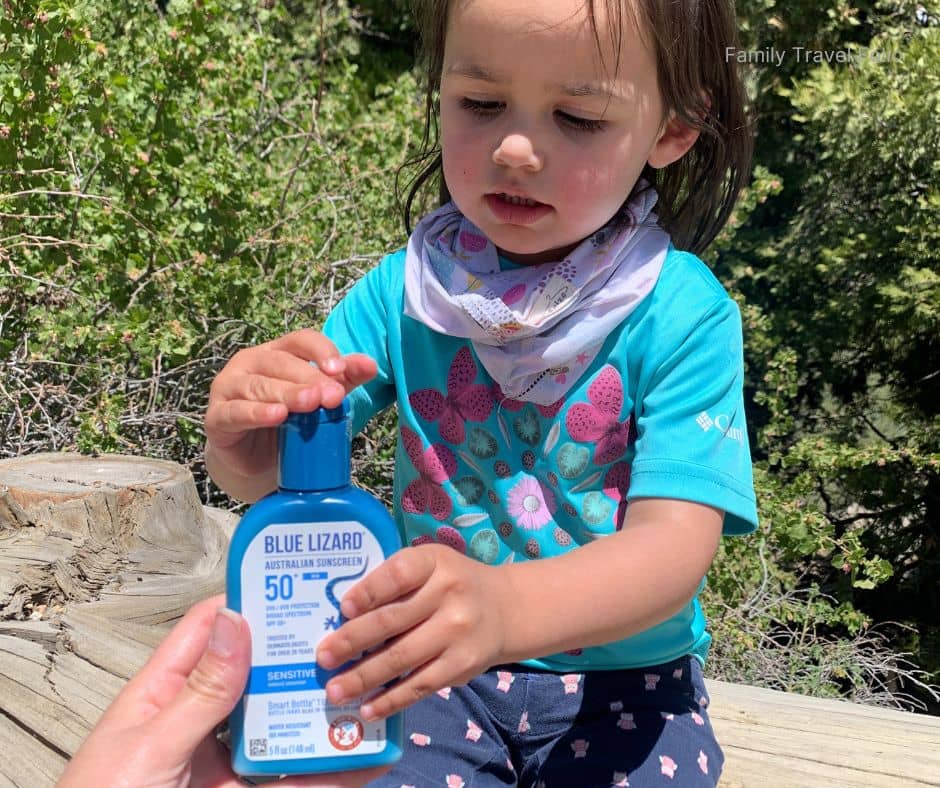
Sun Protection and Hiking Safety
Pack sun protection essentials, including wide-brimmed hats, a shade for the hiking carrier, sunglasses, and reef-safe sunscreen. Our favorite brands are All Good and Blue Lizard.
Pro Tip: Use different types of sunscreen (spray, lotion, stick) to keep kids interested and excited over something new. Much less sunscreen struggles!
A compass and GPS are critical if you’re camping off-grid. We have been to multiple National Parks where there was no cell phone signal on the trail.
My husband downloaded the trail map from AllTrails to his GPS before our trip, and it saved us so many times when the trail wasn’t clear!
Last but not least, don’t leave home without a basic first aid kit. When hiking with children, pack extra band-aids. Even if they get a scrape that doesn’t really need a band-aid, the band-aid magically makes it better. You know what I’m talking about.

Choosing Kid-Friendly Hiking Trails for Beginners
Picking the right trail can make or break your hike—especially with kids in tow. I like to use what I call the DEW method: Distance, Elevation, Weather. For beginners, it’s best to start with shorter hikes and little to no elevation gain. If your little ones are brand new to hiking, flat and shady is your friend. And don’t forget to check the weather before you go—no one has fun hiking in extreme heat (or cold)!
Find a Family Hiking Trail:
- Distance: 1 mile or less for new hikers
- Elevation: Low elevation to start unless you’re used to hiking uphill
- Weather: Try not to hike in the rain, blistering heat, or snow for your first pick
I’m a big fan of AllTrails for finding kid-friendly options. You can filter by distance, difficulty, and even things like waterfalls or views. Trails with cool features—like streams to jump over or big boulders to climb—keep kids curious and engaged the whole way.
Pro Tip: If everyone is starting to get tired and cranky, turn around. You don’t need to complete the full trail for it to count as a hike. End on a positive note!
Also, take a quick look at the trail rating before heading out. Something rated “moderate” might feel more like a full workout when you’ve got a toddler in tow. Loop trails are awesome for families because you’re not retracing your steps, while out-and-backs are nice if you think you might need to turn around early.
We try to hike early in the morning or in the late afternoon—cooler temps and fewer crowds make for a much smoother adventure.
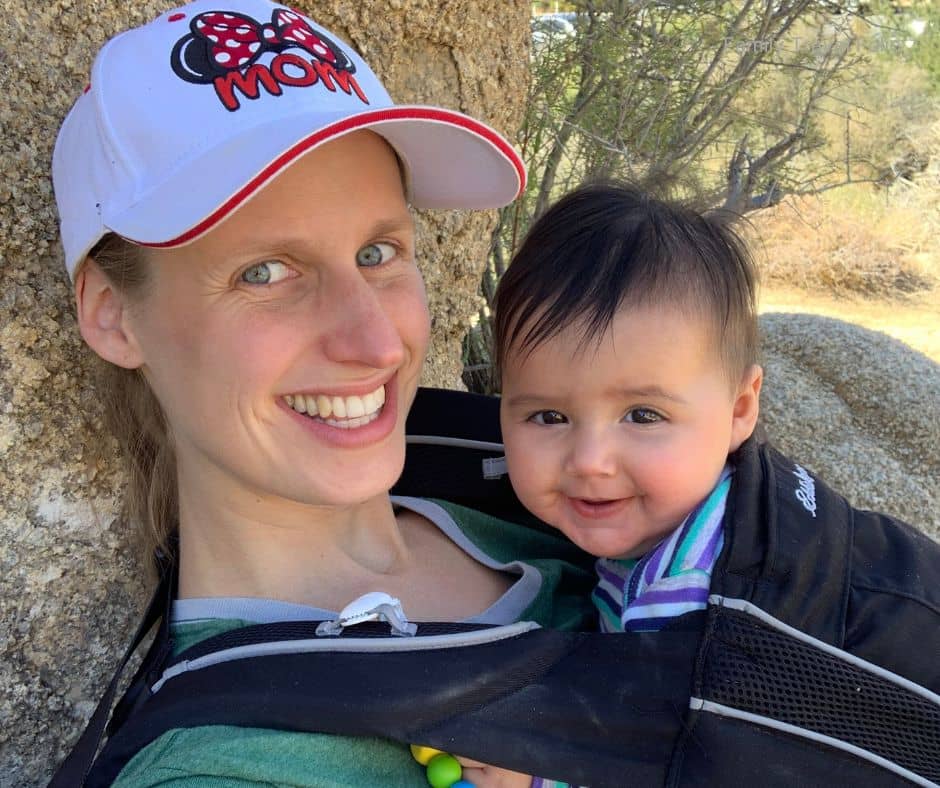
Preparing Your Kids for Their First Hiking Experience
If it’s your first time hiking with your kids, a little prep goes a long way. We love reading books about hiking or watching fun nature videos before our trips to build excitement. Talk about the animals or cool plants they might see. My girls always want to know if there will be butterflies or squirrels!
Before hitting a real trail, take a few “practice walks” around the neighborhood or through a local park. It helps kids get used to being on their feet longer and makes the real hike feel less intimidating.
Start small—like 0.5 to 1 mile—and build up from there. Over time, we worked our way up to 5-7 mile hikes, but that didn’t happen overnight. And definitely let the kids help plan! My girls love choosing snacks or packing their own little backpacks. It gives them ownership of the adventure.
Go over trail basics, like staying on the path, leaving nature where it is, and being quiet enough to hear the birds. We always frame hiking as a fun, family adventure—not a workout.
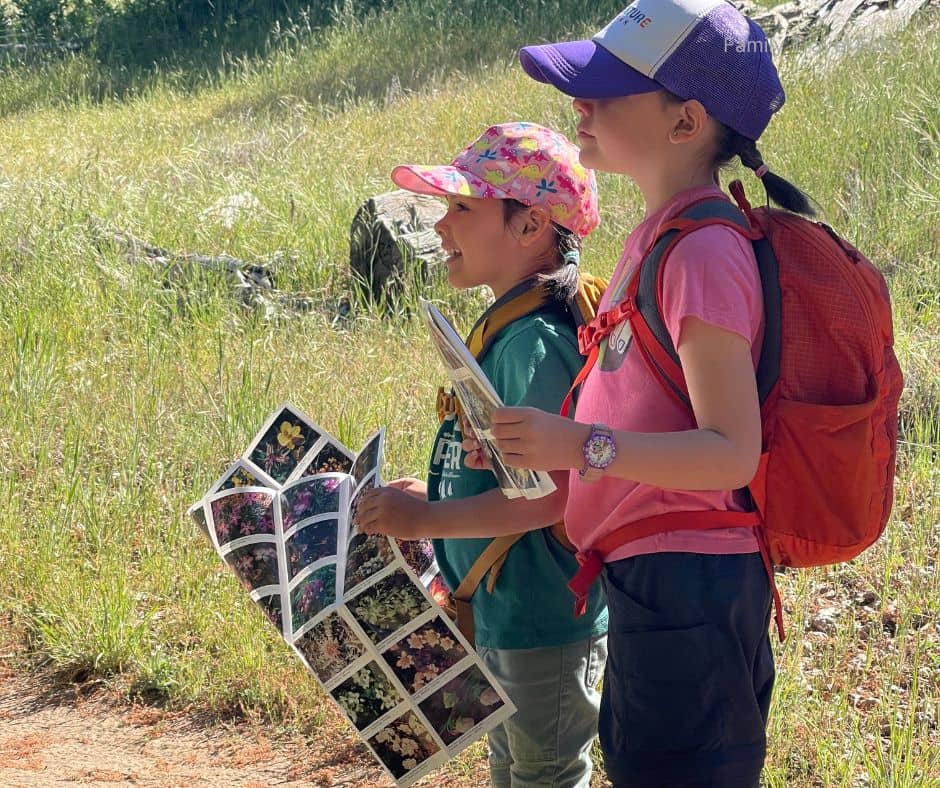
Kid-Friendly Trail Activities to Keep Them Engaged
Let’s be real—kids don’t just want to walk, they want to explore. One of our go-to hacks is a nature scavenger hunt. You can print one off or make it up as you go—find a pinecone, a red leaf, something fuzzy, something smooth.
If your kids are into learning, bring along a simple plant or animal guide. Or try geocaching! It’s like a treasure hunt with a GPS, and it adds a whole new level of excitement to the hike. If you want your kids to have a fun hiking page to fill out as they go, or right after their hike, we have a Hiking Journal Template for multiple ages.
For the quieter moments, we love “listen and feel” activities—close your eyes and name what you hear or touch. And don’t underestimate the power of classic games like “I Spy” or “Guess the animal.” They’ve carried us through many long switchbacks.
Our girls love to practice simple spelling and math problems since they were in pre-K! As babies and toddlers, we did a lot of singing while hiking.
If your kids enjoy being creative, bring a nature journal or let them take photos along the trail. One of my daughters loves storytelling and uses trees and rocks as part of her imaginary world while we hike.
Nutrition and Snacks for Successful Family Hikes
Good snacks = happy hikers. We always pack a mix of fun and functional.
Favorites in our family: Honey Stinger waffles, Kate’s Real Food Bars, and Cheerios clipped to the hiking backpack for easy access. We try to avoid chocolate because the chocolate just melts everywhere.
Hydration is just as important as snacks. We like water bottles with spouts or hydration bladders that are easy for kids to use. Ultima electrolyte packets are a hit with my girls and come in flavors they actually enjoy.
For longer hikes, we bring wraps or sandwiches that are easy to eat mid-trail. And I always pack a few “emergency treats”—you’d be amazed how fast a tough trail section goes when there’s a fruit snack at the next tree!
Just make sure to pack out all your trash and wrappers. Leave No Trace starts early.

Managing Common Challenges on Family Hiking Trips
Even with all the prep, you’ll hit a few bumps—literally and figuratively. If your kids start complaining or dragging their feet, try turning it into a game. We do “race to the next tree” or “find five things that are yellow.” Works like a charm.
Tired legs? No problem. Take a snack break or let them ride in the carrier for a bit. Some days just call for a slower pace, and that’s okay.
Weather can throw a wrench in the plans too. We always pack a light rain jacket or extra layer, just in case. And teaching your kids how to dress for changes in weather gives them more confidence outdoors.
Bathrooms are another tricky one. We bring a foldable potty for our toddler and always pack wipes and a zip-top bag for trash. Privacy breaks behind a tree work in a pinch for older kids—just make sure they know the drill.
Minor scrapes? Pack extra band-aids. Even when they don’t need one, the band-aid somehow fixes everything.
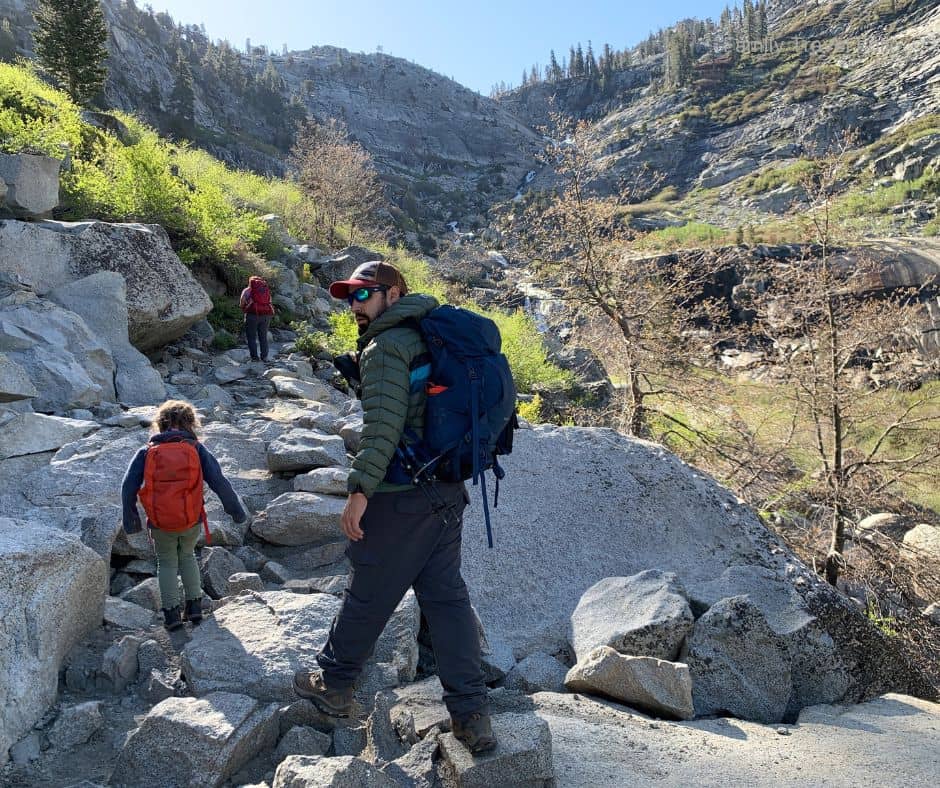
Gradually Building Your Family’s Hiking Abilities
You don’t have to go big from the start. Our hiking journey started with super short trails and grew slowly. The key was consistency—not perfection. Even if we couldn’t hike every week, we tried to get outside regularly. That’s what helped us go from 1-mile strolls to 5+ mile adventures.
We really got off the couch by joining the 52 Hike Challenge. It’s 52 hikes in 12 months, which sounds like a lot. BUT we would do 3-5 short hikes on camping weekends or National Park vacations, so it wasn’t really 1 hike every single week.
As your kids grow, challenge them a little more—add a bit of elevation or a longer route. Watch their confidence build with each trail!
Eventually, you can try backpacking or overnight trips, but it doesn’t need to be your goal right away. For us, it’s always been more about the journey than the distance. Celebrate milestones, like their first solo mile or their first time hiking without the carrier. Those wins matter!
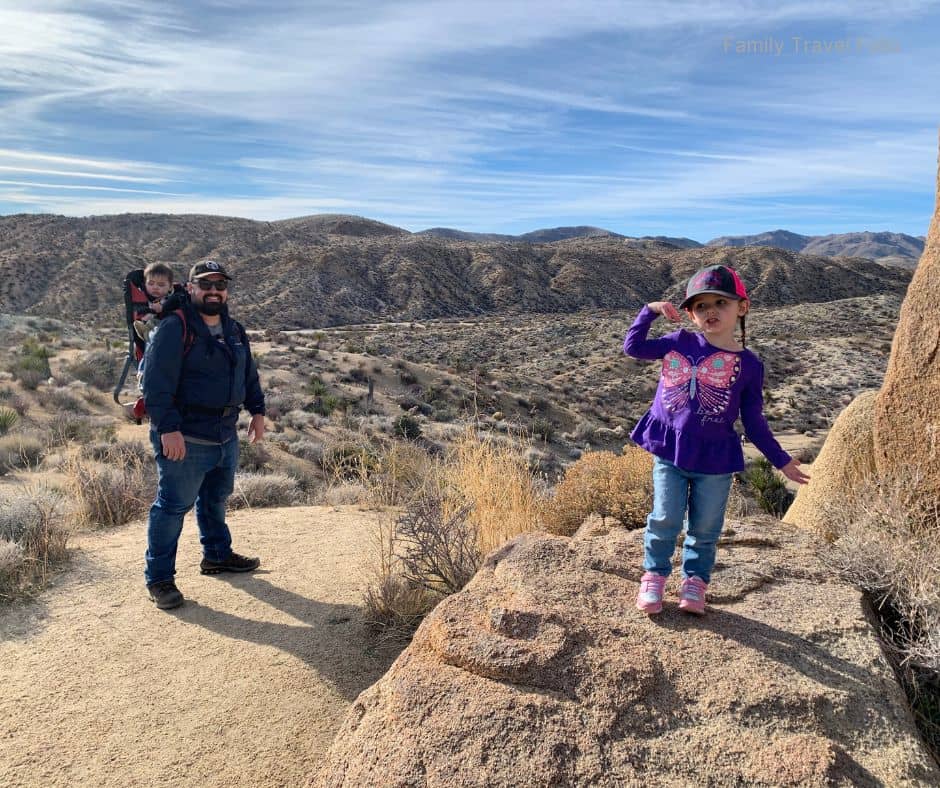
Benefits of Hiking with Kids
Hiking with kids is a fantastic way to enjoy the outdoors and everyone in the family benefits.
Whether you’re exploring family-friendly trails or beginner hiking trails for kids, hiking strengthens muscles, improves coordination, and boosts endurance. It’s also a fun way to get kids outdoors, away from screens and into the fresh air, which helps improve focus and reduces stress.
But it’s not just physical health that benefits. Hiking offers tons of learning opportunities. Kids can explore nature firsthand, identifying plants, spotting wildlife, and getting lessons in conservation along the way. It’s all about real-world outdoor education for children that you just can’t get from a textbook.
We love visiting State Parks and National Parks to learn from their free Junior Ranger Program. Our girls love the stickers, badges, and activity books they get!
Another huge perk is family bonding. Hiking with kids creates memories and traditions that will last for years.
We often go hiking with multiple children because of friends or cousins who join the adventure. The kids get to explore together while the parents chat, and everyone gets to have fun bonding over the shared experience.
Hiking is also a great way to help kids build important life skills like resilience, problem-solving, and independence.
We love to let our kids lead the way, figure out the map, and even try out a compass. As they navigate the trail, they learn how to assess risks and make decisions, all while developing confidence.
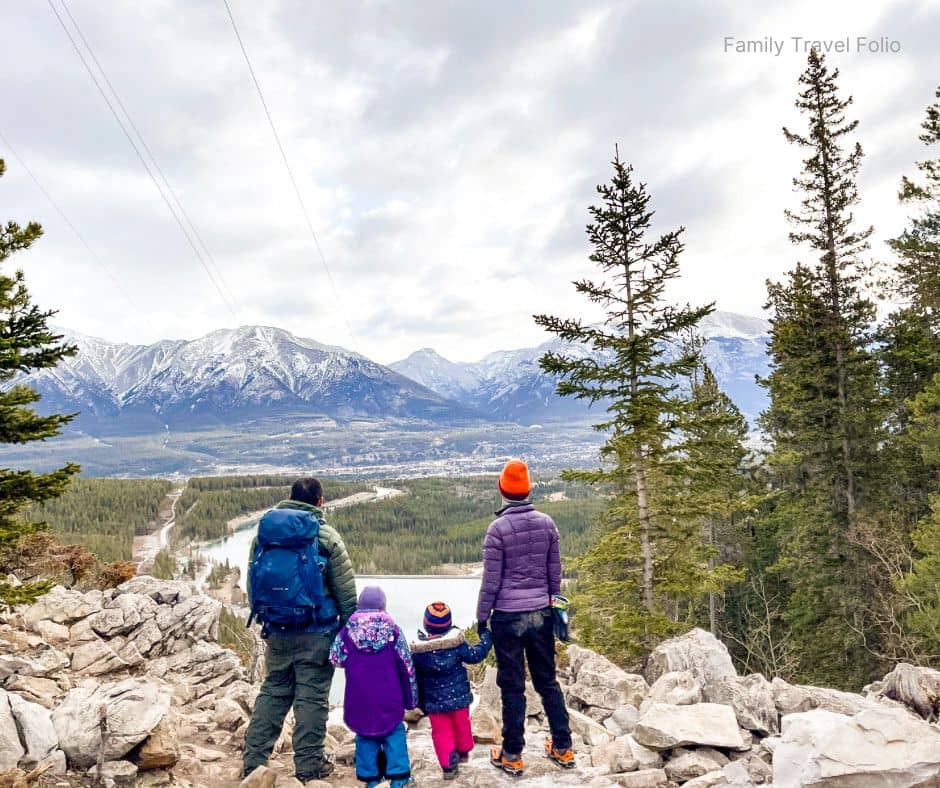
Summary of How to Start Hiking with Kids
Hiking with kids might sound overwhelming, but once you try it, you’ll see it’s one of the best ways to spend time as a family. Start small, go slow, pack snacks, and keep it fun. You don’t need fancy gear or extreme trails to make memories—you just need to get outside together.
And don’t forget: it’s okay to stop and look at every cool bug or oddly shaped rock. That’s part of the magic. The goal isn’t the summit—it’s the shared experience along the way.

